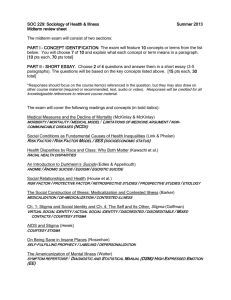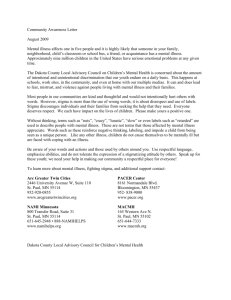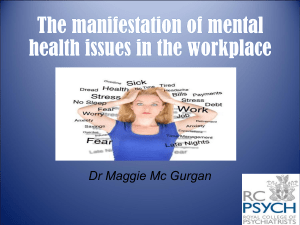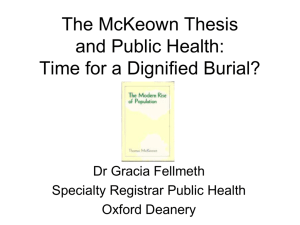FOCP Revision Notes
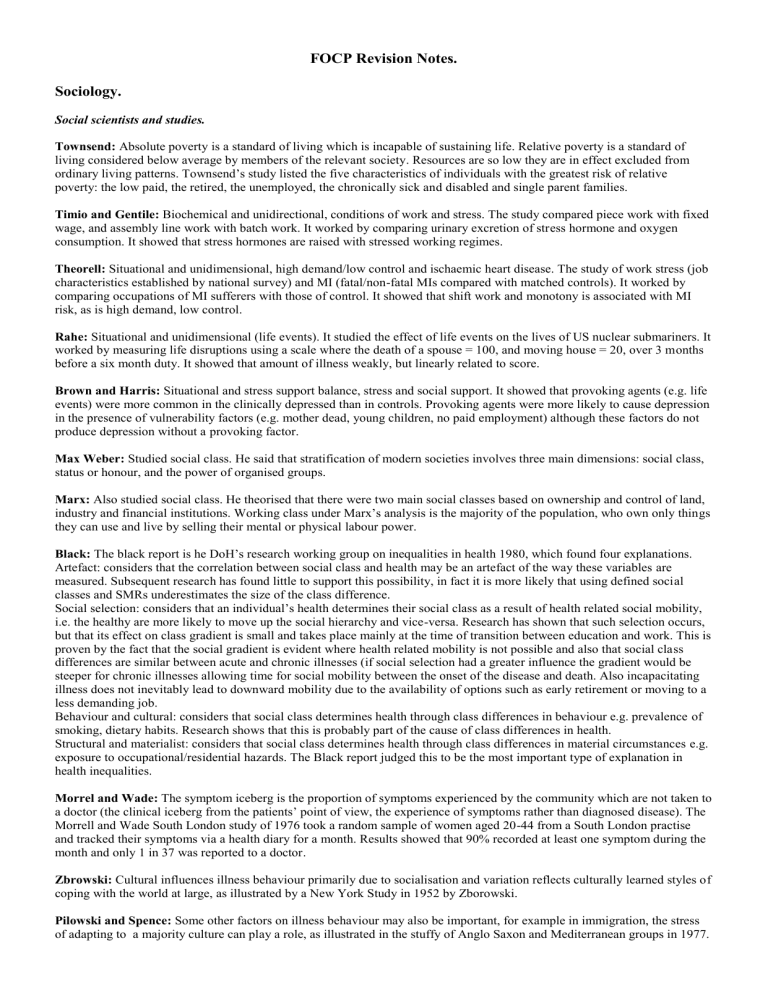
FOCP Revision Notes.
Sociology.
Social scientists and studies.
Townsend: Absolute poverty is a standard of living which is incapable of sustaining life. Relative poverty is a standard of living considered below average by members of the relevant society. Resources are so low they are in effect excluded from ordinary living patterns. Townsend’s study listed the five characteristics of individuals with the greatest risk of relative poverty: the low paid, the retired, the unemployed, the chronically sick and disabled and single parent families.
Timio and Gentile: Biochemical and unidirectional, conditions of work and stress. The study compared piece work with fixed wage, and assembly line work with batch work. It worked by comparing urinary excretion of stress hormone and oxygen consumption. It showed that stress hormones are raised with stressed working regimes.
Theorell: Situational and unidimensional, high demand/low control and ischaemic heart disease. The study of work stress (job characteristics established by national survey) and MI (fatal/non-fatal MIs compared with matched controls). It worked by comparing occupations of MI sufferers with those of control. It showed that shift work and monotony is associated with MI risk, as is high demand, low control.
Rahe: Situational and unidimensional (life events). It studied the effect of life events on the lives of US nuclear submariners. It worked by measuring life disruptions using a scale where the death of a spouse = 100, and moving house = 20, over 3 months before a six month duty. It showed that amount of illness weakly, but linearly related to score.
Brown and Harris: Situational and stress support balance, stress and social support. It showed that provoking agents (e.g. life events) were more common in the clinically depressed than in controls. Provoking agents were more likely to cause depression in the presence of vulnerability factors (e.g. mother dead, young children, no paid employment) although these factors do not produce depression without a provoking factor.
Max Weber: Studied social class. He said that stratification of modern societies involves three main dimensions: social class, status or honour, and the power of organised groups.
Marx: Also studied social class. He theorised that there were two main social classes based on ownership and control of land, industry and financial institutions. Working class under Marx’s analysis is the majority of the population, who own only things they can use and live by selling their mental or physical labour power.
Black:
The black report is he DoH’s research working group on inequalities in health 1980, which found four explanations.
Artefact: considers that the correlation between social class and health may be an artefact of the way these variables are measured. Subsequent research has found little to support this possibility, in fact it is more likely that using defined social classes and SMRs underestimates the size of the class difference.
Social selection: considers that an individual’s health determines their social class as a result of health related social mobility, i.e. the healthy are more likely to move up the social hierarchy and vice-versa. Research has shown that such selection occurs, but that its effect on class gradient is small and takes place mainly at the time of transition between education and work. This is proven by the fact that the social gradient is evident where health related mobility is not possible and also that social class differences are similar between acute and chronic illnesses (if social selection had a greater influence the gradient would be steeper for chronic illnesses allowing time for social mobility between the onset of the disease and death. Also incapacitating illness does not inevitably lead to downward mobility due to the availability of options such as early retirement or moving to a less demanding job.
Behaviour and cultural: considers that social class determines health through class differences in behaviour e.g. prevalence of smoking, dietary habits. Research shows that this is probably part of the cause of class differences in health.
Structural and materialist: considers that social class determines health through class differences in material circumstances e.g. exposure to occupational/residential hazards. The Black report judged this to be the most important type of explanation in health inequalities.
Morrel and Wade: The symptom iceberg is the proportion of symptoms experienced by the community which are not taken to a doctor (the clinical iceberg from the patients’ point of view, the experience of symptoms rather than diagnosed disease). The
Morrell and Wade South London study of 1976 took a random sample of women aged 20-44 from a South London practise and tracked their symptoms via a health diary for a month. Results showed that 90% recorded at least one symptom during the month and only 1 in 37 was reported to a doctor.
Zbrowski: Cultural influences illness behaviour primarily due to socialisation and variation reflects culturally learned styles of coping with the world at large, as illustrated by a New York Study in 1952 by Zborowski.
Pilowski and Spence: Some other factors on illness behaviour may also be important, for example in immigration, the stress of adapting to a majority culture can play a role, as illustrated in the stuffy of Anglo Saxon and Mediterranean groups in 1977.
Zola: Lay referral system is the discussing of symptoms with a persons’ social network of family and friends before consultation. The characteristics which may influence consultation rate include:
Expectations: vary between subcultures, e.g. working class equate health as being able to keep going, middle class expect more, a feeling of strength and well being, and therefore consult with less disruptive symptoms. It also varies with age.
Disruption: the social network may be able to accommodate the disruption caused by a symptom (Zola described the way this accommodation can break down). Change in accommodation may trigger a consultation rather than a change in the symptoms.
Culture and subculture: the middle class social networks are more likely to give advice with which a doctor agrees. This is less likely where the network’s culture differs from the doctor’s, especially when the network is large and tightly knit.
Zola’s five triggers are unit by the phenomenon of late presentation. The fact that most people tolerate their symptoms for a limited time before they went to a doctor, and that the symptoms themselves were often not sufficient to precipitate a consultation and this action required a trigger:
1. The occurrence of an interpersonal crisis (loss of social network accommodation).
2. Perceived interference with social or personal relations.
3. Sanctioning pressure from others to consult.
4. Perceived interference with vocational or physical activity.
5. Setting of a deadline (e.g. if I feel the same on Monday then I’ll consult.
Wadsworth et al: studied the one month prevalence of symptoms in the community and the range and importance of the responses to them. A 14 day incidence of symptoms and subsequent illness behaviour of 1000 randomly selected persons from two London boroughs. 49 were symptom free, 188 had symptoms but took no action. 562 had symptoms and took non medical action, 196 had symptoms and sought a medical consultation. 5 became hospital in patient admissions. 95% had reported symptoms, only 20% had consulted.
Parsons: saw illness as unwilled or non responsible deviance, the sick role as a temporary social role (even in chronic illness) instituted by society with the aim of returning people to a state of health as full functioning members of society. Its obligations and expectations apply to all sick people whatever their age, gender, ethnicity, occupation or status.
Goffman: Stigma is defined by Goffman as ‘the situation of an individual who is disqualified from full social acceptance’.
Stigmatised diseases include epilepsy and schizophrenia, or surgical procedures such as colostomy. It is a result of an unwilled illness which implies neglect, avoidance and humiliation rather than punishment. ‘Normals’ discriminate against those who they stigmatise. Neglect stigma involves avoidance and humiliation. Punitive stigma is the infliction of punishment and is less common. Discredited stigma is immediately obvious or widely known for example amputees or the physical handicapped.
Discreditable stigma is occasionally apparent and is neither obvious nor known for example epilepsy of HIV positive status.
Davis: studied tension management in the physically handicapped, and found they pass through three stages when meeting strangers. Firstly there is fictional acceptance (polite acceptance of the stigmatised person as long as the other stereotypes are not challenged). Secondly breaking through (others realise the stigmatised is normal apart from the stigmatising characteristic).
Finally consolidation (maintaining others’ perception of the previously stigmatised person as normal). The advantages of tension management are that everything is out in the open. Disadvantages are that it demands great practice and continual effort and social skill. Consolidation is rarely permanent.
Scrambler: Information management involves the passing as normal, by people suffering from discreditable stigma.
Advantages are that it avoids the stress of coping with other people’s reactions and discrimination. Disadvantages are that it causes anxiety and stress in making cover stories consistent and hearing what normals say in passing on the belief that the stigmatised are not present.
McKeown: McKeown researched what might have contributed to the fall in infective mortality and assigned relative importance to them:
Increased host resistance: McKeown concluded that this must have been the main cause. Improvements were made in the living standards and most importantly diet. Other social factors such as decreased exhaustion, fewer pregnancies, and smaller families lead to a shorter working week.
Decreased exposure: measures by government to reduce exposure e.g. sanitary reforms (separating drinking/washing water from the sewerage system. It was most effective against water-borne and vector borne infections, and also marginally on air borne infections which were responsible for the majority of deaths.
Medical measures: by the early 20 th century medicine had two partially effective measures against infective diseases.
Vaccination against small pox and diphtheria anti-toxin against diphtheria. The effect on total mortality was small because by
1900 smallpox and diphtheria were not among the most prevalent causes of death. Immunisation and antibiotics are the main weapons against infectious disease, but they did not become available until the late 1940s by which time some 75% fall in infective mortality had already occurred, too late to have been responsible for the main part of the decline.
Decreased virulence (decrease in the likelihood that an infection will kill): may have been part of the explanation for the fall in deaths due to scarlet fever, but is implausible as a general explanation because all infections virulence would not decrease at the same time.
McKeown influenced WHO policies on the third world and British policies on the NHS. McKeown though the NHS should place more emphasis on health promotion and disease prevention and less on attempts at cure which rarely succeed.
Controversy surrounded his suggestions, but certain reasonably safe implications can be drawn from McKeown’s work:
Health pf populations: a population’s mortality rate and its main cause of death reflect its standard of living and way of life.
Medicine can affect these but it is not their main determinant.
Prevention: the most effective medical interventions, either clinical (immunisations) or campaigns for social change (smoking cessation). Medical care: not the main determinant, but it makes an enormous difference to a patient’s experience of being ill.
Egbert: researched they physiological response to therapy. His experiment was on communication, lowering anxiety and the need for analgesia and speed of recovery after surgery.
Szasz-Hollender: The Szasz-Hollender typology describes four clinical levels (unconscious/anaesthetised, acutely ill, managing a chronic disease, and healthy patient requesting assistance), each having an appropriate DPR. Additional factors include setting of the consultation, the props of the doctor’s authority (number of staff present, patient undressed or in bed, patient alone) diminish moving from hospital inpatient to OPD to GP., social distance between doctor and patient (doctors are class I), and financial arrangement (private consultations last longer, fee paying patients often feel more confident).

